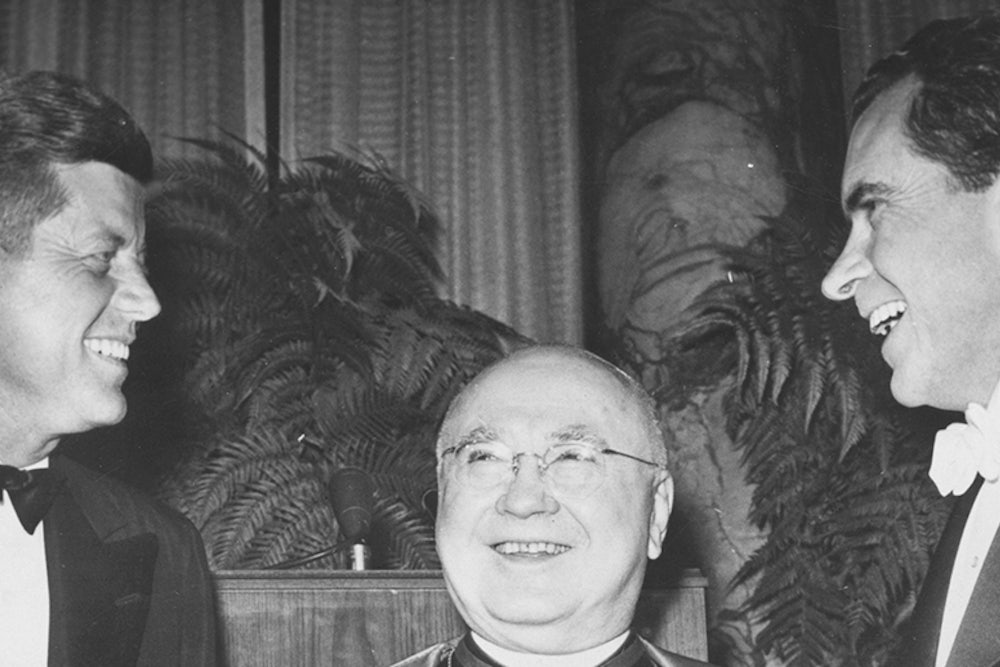It has been estimated that the joint TV appearances by the Presidential candidates are costing the networks something like $2 million in lost revenues for prime viewing time. Now $2 million is a tidy sum, but assuming that at least 50 million Americans go to the polls on November 8, the broadcasters are passing up all of four cents per voter - so that we may compare our candidates in debate. Nor is $2 million a prohibitive percentage of network earnings. ABC's net earnings in 1959 were $7,967,000 - an increase of 49 percent over the previous year. Coming after the rigged shows, the poor shows, the payola scandals, conscience money at four cents per head is a small price for the broadcasters to pay to scrub up a dirty face.
But what of the debates themselves? We've seen enough to be sure there has been a pre-occupation with trivia, a slighting of matter for manner. So obsessed was ABC with insuring equal treatment to both candidates on the third debate that the producer insisted Kennedy's desk in a New York studio and Nixon's desk in Los Angeles be daubed with paint literally from the same can. (The can was flown across the country). To be consistent as well as ridiculous, the producer should have further required that the desks be constructed from wood cut from the same tree. Might the desks otherwise refiect light with some minute degree of difference, even though the paint was the same? (It was all love's labor lost anyway, since most of the shots were over their differences across the same closeups; the viewer hardly ever saw those desks!)
This predilection for how the debates look as a "show" rather than for full elucidation of the candidates' views amounts to a form of jamming that interferes with the exploration of issues. There's some doubt too whether the avoidance of direct confrontation is an asset to the debates. Lincoln and Douglas climbed up on the same platform, took up positions toe to toe, and slugged it out. One hundred years later, the candidates are safely separated on stage sets exuding the sterile atmosphere of a hospital operating room. On the first program, Kennedy and Nixon were placed so far apart they couldn't have communicated with each other, except over TV. And way out in the limbo of an immense no-man's land was poor Howard K. Smith, through whom all the questions were channeled.
By the second debate, the candidates had moved somewhat closer together physically, at the same time moving farther apart ideologically. And the moderator was happily dispensed with as an intermediary in the question and answer routine. But this time the correspondents seemed to hang exotically from the ceiling somewhere.
The third debate, with Nixon speaking from California and" Kennedy from New York, of course enforced a separation, though they seemed to be closer together. In the fourth encounter. Senator Kennedy did manage once or twice to convey the impression that he and Mr. Nixon were within shouting distance of each other. Once the camera caught him reacting spontaneously to some advice from his opponent - he almost laughed. And, at another point, he even raised his arm and pointed to the Vice President. Perhaps some day, the candidates will sit down and talk at the same table. At any rate the interlocutors ought to be dispensed with. The candidates know the issues, or should. Why not let them question each other? The present format not only requires the questions to be raised by third parties, but it limits the responses to one statement by each of the candidates, thus almost assuring that no one can get to the heart of any issue. This was glaringly revealed on the third debate, when Kennedy and Nixon finally began going at each other over Quemoy and Matsu. Their exchange was abruptly cooled off by an irrelevant (at that instant) question about Mr. Truman's language.
By dismissing the panel of correspondents and letting the candidates quiz each other a question could be clarified more to the satisfaction of both parties (and the audience) before moving on to the next subject. Further, the very act of requiring the candidates themselves to put the questions would itself be revealing. Listening to the queries put by the candidates, the voters could better measure the men. Such a revised format would eliminate the need for the time clock, which now provides only equality of form, not of substance. If the candidates didn't have to keep a worried eye cocked on that inexorable sweeping second hand they could look with more concentration upon the issues. Moreover, if David Susskind can have two to three hours for his questions, mightn't the candidates be granted equivalent time on five shows every four years?
In presenting these debates, the broadcasters have only begun to discharge their obligation to operate in the public interest. They still have a long way to go. For instance, in what has been called the intellectual ghetto into which most of the egghead programming is crowded on Sundays, NBC and CBS are forcing the thinking audience to make an arbitrary choice between "Meet the Press" and "Face the Nation," which at present are scheduled at the same hour. With the "great debates," TV is reaching the largest audience in history (estimated in some quarters at 70 million). Never before has such a large percentage of the American community been assembled for a public discussion of the great issues of the day. Why not do it more often - and in the 200-odd weeks between Presidential elections?
